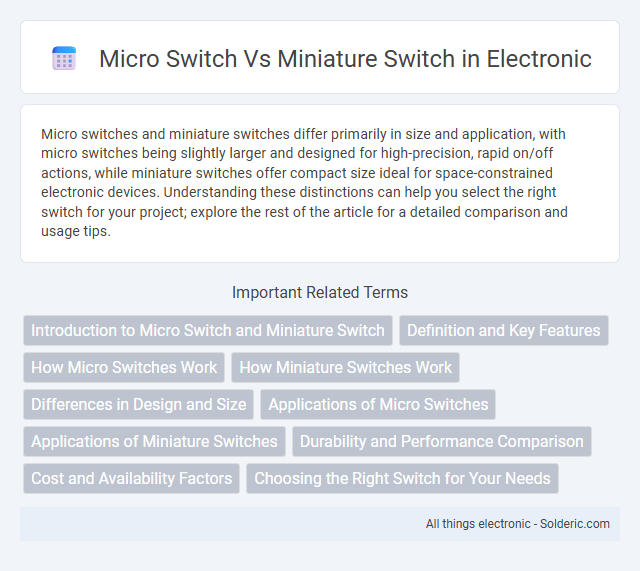Micro switches and miniature switches differ primarily in size and application, with micro switches being slightly larger and designed for high-precision, rapid on/off actions, while miniature switches offer compact size ideal for space-constrained electronic devices. Understanding these distinctions can help you select the right switch for your project; explore the rest of the article for a detailed comparison and usage tips.
Comparison Table
| Feature | Micro Switch | Miniature Switch |
|---|---|---|
| Definition | Small, sensitive switch actuated by minimal physical force | Compact switch with smaller size than standard, used in limited space |
| Size | Generally larger than miniature switches | Smaller and more compact than micro switches |
| Actuation Force | Very low actuation force, typically 50-200 grams | Variable, often slightly higher than micro switches |
| Applications | Limit switches in machinery, safety devices, appliances | Electronics, small devices, precision equipment |
| Durability | High mechanical reliability with millions of cycles | Good durability but generally fewer cycles than micro switches |
| Contact Rating | Typically 3 to 15 amps at 125-250V AC | Lower current rating, around 0.1 to 3 amps |
Introduction to Micro Switch and Miniature Switch
Micro switches and miniature switches are precise electromechanical devices designed for detecting position or controlling circuits in compact spaces. Micro switches typically feature a robust design with a snap-action mechanism, ensuring reliable and rapid switching even under high-stress conditions. Your choice between these switches depends on the size constraints and application requirements, as miniature switches offer smaller footprints while maintaining sensitivity and accuracy.
Definition and Key Features
Micro switches are compact, highly sensitive switches that operate with a minimal physical force, utilizing a snap-action mechanism to ensure rapid and reliable switching. Miniature switches are a subset of micro switches, designed to occupy less space while maintaining similar performance characteristics, making them ideal for compact electronic devices. Your choice between the two depends on space limitations and the specific actuation force required for your application.
How Micro Switches Work
Micro switches operate using a small internal actuator mechanism that responds to minimal physical force, triggering an electrical connection with high precision and reliability. These switches employ a snap-action mechanism, allowing rapid opening or closing of circuits, which ensures durability and consistent performance even under frequent use. Your devices benefit from micro switches' efficient design by enabling accurate control in applications like safety interlocks, appliances, and automation systems.
How Miniature Switches Work
Miniature switches operate by utilizing a small, precise mechanism that opens or closes electrical circuits when actuated by minimal force, often through a lever or button. These switches typically feature a snap-action mechanism that ensures rapid switching, enhancing reliability and reducing contact wear. The compact design allows them to efficiently control low-current and low-voltage signals in tight spaces, making them ideal for applications requiring precise control and durability.
Differences in Design and Size
Micro switches feature a compact, lever-actuated design ideal for applications requiring precise, quick-response switching in tight spaces. Miniature switches are generally smaller than micro switches, designed for extremely limited spaces with lower electrical ratings and simpler actuator mechanisms. Understanding these differences in design and size helps you select the appropriate switch for your specific electronic or mechanical project needs.
Applications of Micro Switches
Micro switches are widely used in industrial machinery, automotive systems, home appliances, and medical devices due to their high reliability and precise actuation. They excel in applications requiring rapid switching and consistent performance, such as limit controls, safety interlocks, and position detection. Miniature switches, although similar, are often preferred for compact electronic devices with space constraints but generally handle lower load capacities compared to micro switches.
Applications of Miniature Switches
Miniature switches are widely used in applications requiring compact, reliable switching solutions such as consumer electronics, medical devices, and automotive controls. Their small size enables integration into tight spaces for precise control in devices like handheld instruments, thermostats, and security systems. You can rely on miniature switches for consistent performance in low-current, high-precision environments.
Durability and Performance Comparison
Micro switches typically offer higher durability with millions of reliable cycles due to their robust internal construction, making them ideal for high-use applications. Miniature switches, while smaller and more compact, often deliver slightly less longevity but excel in precision and space-saving design. Your choice should balance the need for durable performance with the constraints of size and application requirements.
Cost and Availability Factors
Micro switches generally offer a lower cost due to their widespread use and simpler design, making them readily available from various manufacturers. Miniature switches, while often more expensive, provide advanced features and smaller form factors, which can limit availability to specialized suppliers. Your choice depends on balancing budget constraints with the specific performance requirements of your application.
Choosing the Right Switch for Your Needs
Micro switches and miniature switches differ primarily in size and application precision, with micro switches offering higher durability and reliability for heavy-duty tasks, while miniature switches excel in compact electronic devices requiring space-saving components. Choosing the right switch depends on your specific requirements for load capacity, operating force, and environmental conditions, ensuring optimal performance and longevity. Evaluate the electrical ratings, mechanical life, and design constraints to match the switch precisely to your device's function.
micro switch vs miniature switch Infographic

 solderic.com
solderic.com